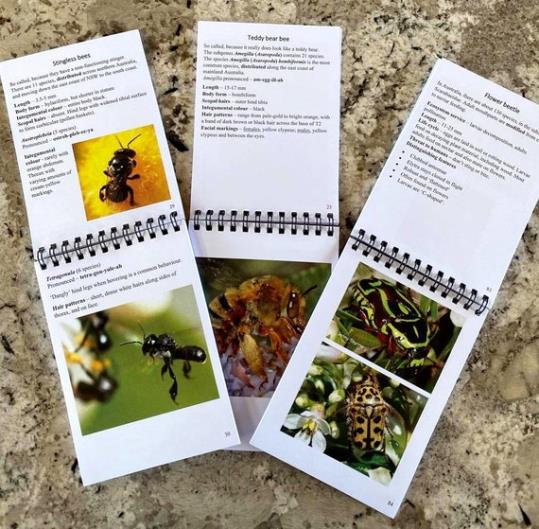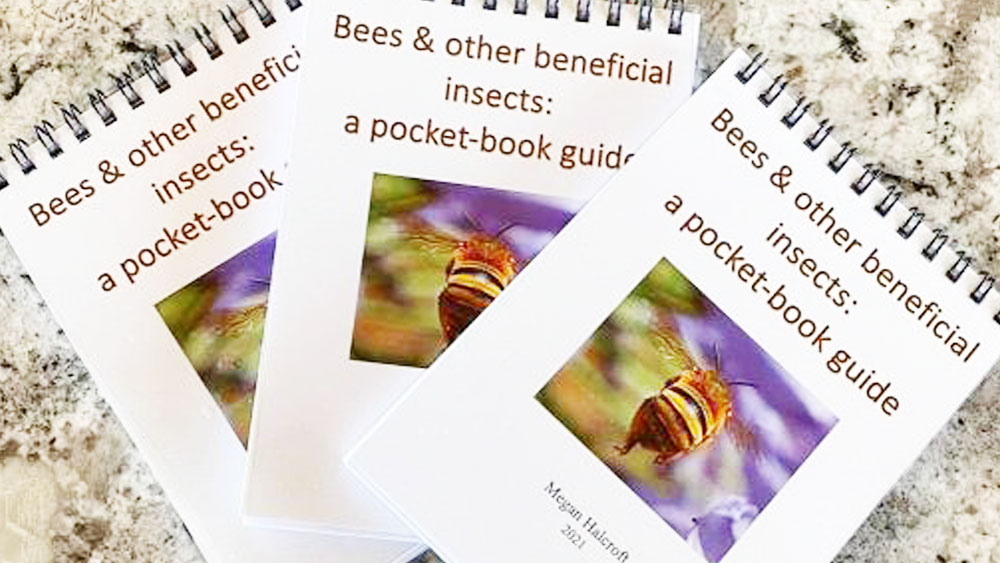By Megan Halcroft, Bees Business
Review by Alex Griffiths, native beekeeper and founder of Little Bee & Me, educator at Little Bee’s Secret Garden.
With over 1660 named species, and an estimated 2000-2500 total species count, the diversity of Australia’s native bees is a large and comprehensive topic. As awareness grows, our native bees are becoming more well known, and interest in them is growing exponentially. This makes the timing of this pocket-guide well-placed to assist bud-ding gardeners, and bee and bug enthusiasts to identify the critters in their garden.
In “Bees & other beneficial insects: a pocket-book guide” Megan Halcroft provides a great easy-to-digest reference for beginner entomologists, bee- and bug-enthusiasts, gardeners, and nature explorers. This is a straight-forward field-guide to assist in identifying the most common bees and bugs we find outside. Halcroft has summarised her extensive knowledge into bite-sized chunks of infor-mation, leading with the details most relevant to field identification. Descriptions, and large pictures, are used throughout plus a simple summary in table form (page 17/18). In combination these are effective in supporting the reader in their quest to identify the most commonly observed species.
The book is divided into Sections 1 and 2. Section 1 covers just a small selection of our 2000+ species of native bee. Section 1 is further broken down into FAQs, a glossary (very useful for those learning scientific terms), bee anato-my, how to differentiate between male and female bees, and between bees, wasps and flies, a body-form sum-mary. The table called “Bees at a Glance” provides a sim-ple starting point for those with no knowledge to narrow their identification down to species. The section then con-cludes with a description, photo, and brief introduction to a variety of the most commonly observed native bees, although this would vary depending on your location. Two introduced exotic species are included for comparison, which is a worthwhile addition as these are often errone-ously believed to be native.

Section 2 covers some of the other common beneficial insects in our outdoor environments. It opens with a brief reminder that all bugs are not necessarily evil or require killing, with a stark reminder of our need to support the balance of nature by stopping or reducing the use of pesti-cides. Halcroft summarises with the simple but powerful explanation that beneficial bugs “provide ecosystem ser-vices such as pollination, pest control, water filtration, composting, and enhancing biodiversity”. As a native bee-keeper, enthusiast, and gardener with less knowledge of bugs than of bees, I found Section 2 an exciting addition to this pocket-guide. Any gardener or beekeeper will likely encounter these other species of garden critters just as frequently as the bees we adore, so it was judicious to include it.
This book is well-priced, and easily found online with a google search, which makes it very accessible. It is easy to carry as it’s designed to be pocket-sized (only slightly big-ger than an iPhone 11), so perfect for in the garden or out bushwalking (assuming your gear has pockets). I was not disappointed and find this pocket-guide useful. It will be indispensable to newcomers to the bee and bug world, or beginner gardeners and bushwalkers.
126 pp. Price $16.50. ISBN 9780645101300
https://www.etsy.com/au/listing/981287672/bees-other-beneficial-insects-a-pocket
Alex Griffiths https://www.littlebeessecretgarden.com

